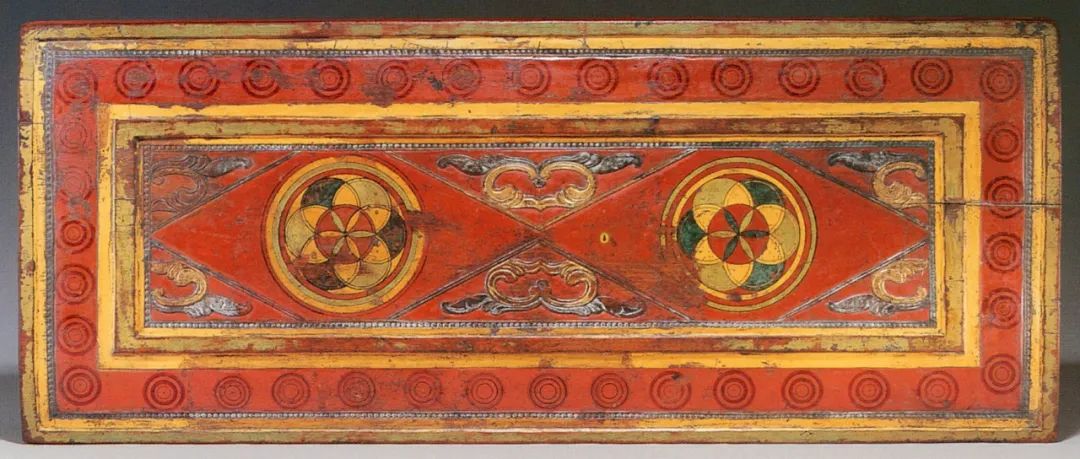
Ancient art on wooden planks: Himalayan scripture boards (གླེགས་ཤིང་)

Wooden Carved Exquisite Senghe Zushi Victorious Image Tablet with Scriptures
Bon Religion, late 15th century, private collection
The Victorious Image (རྣམ་པར་རྒྱལ་བ་) is a special incarnation of Dzogchen Senghe.

"Painted Wooden Three Towers Thangka"
Benzhu religion, late 14th century, private collection
The sides of the thangka are painted with male and female Benzhu followers from the western Tibetan region.
The Benzhu follower under the three towers appears to be the central benefactor.

"Wood Carved Triptych of Three Buddhas and Eight Bodhisattvas with Sutra Inscribed Panels"
Late 13th century, in the collection of the Rubin Museum

"Rosewood Inlaid with Gemstones Metal-Bound Scripture Board"
From the collection of the Rossi family, mid-13th century

"Red sandalwood polychrome carved mantra board"
Late 14th century, in the collection of the Rubin Museum
Buddha - Five Dhyani Buddhas - Three Protectors

"Wooden carved Lanzawen decorative clip panel"
Late 14th century, Baylis family collection

"Inner and Outer Pair of Metal Decorated and Painted Sutra Panels"
Late 12th century, Rossi Family Collection
Inner Sutra Panel A: Fudo Myoo - Three Buddhas - Avalokiteshvara Bodhisattva
Inner Sutra Panel B: Central figure of Prajnaparamita Buddha Mother
Those exquisite and fragile wooden book covers
They bear witness to the connection between various artistic styles and the Tibetan region
Inside the wood, there are texts recording the life and teachings of the Buddha
While outside, it is still the same world full of the three poisons and suffering
Excerpt from "Protecting Wisdom: Tibetan Book Covers from the MacLean Collection"
By Kathryn Selig Brown(American art historian)

"Protecting Wisdom: Tibetan Book Covers from the MacLean Collection",2012
This book is the first comprehensive research report on the topic of fold boards.
So far, research on the art of Tibetan bookmaking still has many shortcomings in the academic field, excluding exhibition catalogs and collection studies.
This type of art is conventionally labeled as a footnote in the "writing-thought" history.
In addition to emphasizing the taxonomy derived from the material form, concerning the Tibetan book art, specifically the Tibetan book covers (གླེགས་ཤིང་; or book covers), at least four points need further exploration in the future.
1. The historical origin and localized variants of existing Tibetan book covers systems.
2. The spiritual heritage behind Tibetan book covers (such as within monasteries).
3. The notion of offerings behind Tibetan book covers and the major events involved.
4. The decorative system and art historical value of Tibetan book covers in the region.

"Painted Buddha and Bodhisattva Sutra Board on Birch Wood"
Dating back to around the 7th century, unearthed from the Gilgit region of Pakistan
Collection of Kashmir University (featuring donor inscription at the bottom)

"Wooden Painted Deer Garden Initial Rotating Dharma Wheel Sutra Clip Board"
Mid 9th to 10th century
Kashmir region, Metropolitan Museum of Art collection
Originally used to string together clipboards and scriptures with circular holes
Preserved in the tradition of Tibetan writing with red circles

"Wooden Painted Sutra Board of the Heart Sutra" and scripture
From the mid-11th century, in the collection of Shannan Museum

"The Heart Sutra" Wooden Painted Sutra Board
Private collection, 11th to 13th century
From the imperial period to the early phase of the post-Buddhist spread, the carved scripture boards in Tibet continued to be mainly influenced by finished products from South Asia and Central Asia.
For example, gifts received by the great translator Lotsawa Rinchen Sangpo.
The western Tibetan region was an important source of local Tibetan scripture board art, while the central Tibetan region promoted the creation and circulation of local scripture boards.
(The influence even reached later periods in China and Mongolia.)
Carved scripture boards and painted scriptures seem to have developed as two independent art forms, with the latter's localization process occurring earlier.
The Tibetan scripture boards were mostly influenced by Kashmir and Nepal, filling the material gap in South Asian art research.

"The True Name of Manjushri and Scriptures on the Tablet"
From a private collection in the mid-16th century.

Wooden painted panel of various images of the Buddha and the Guru
Late 14th century, private collection
On the left is Vajrabhairava and on the right is Sachen Gongpa Nyingpo

"The Ornate Doctrine of Present Observation" Scripture Board and Texts
Late 15th century, Arthur M. Sackler Museum collection
Commissioned by monks from the Himalayas and crafted by artisans in Kathmandu

"Wooden Carved Three Lotus Flower Plate with Celestial Figures and Sutra Clip"
From the collection of the Rossi family, late 12th century
The gemstones in the three lotus flowers symbolize the Three Jewels of Buddhism
The intricate carvings on the sutra clip can be compared to the wooden carvings at the Jokhang Temple.

"Wooden Painted Geometric Patterned Side Table with Halo Edge"
Early 15th century, Private collection

"Wooden Painted Buddha Teaching Sutra Board"
From Kashmir region, around the 9th century, in a private collection.

"Wooden Painted Lama Zanabazar Buddha and Two Bodhisattvas Sutra Board"
Mongolia, early 19th century, Inga Pan style
This sutra board (with a complete set of scriptures) appears to have been given by the Qing imperial court.
The material of the Tibetan sutra board is mainly birch and rosewood, with additional options including full metal, wood inlaid with metal, and wood inlaid with precious stones.
Artisans in classical times balanced the durability and aesthetic value of the objects.
The three core themes of early Tibetan sutra board art are "Prajna Buddha Mother", "Life of Buddha", and "Buddha Bodhisattva combination".
Complex decorative combinations and geometric designs (including various textures) have become favorite themes of local artists with more pronounced secularization.
Tibetan sutra board art can be considered as an important extension of traditional art history, showing noticeable variations in details and symbol evolution.

"Wooden Colorful Painting of the Ten Incarnations of Vishnu on a Board"
From the 17th century, in the Nepal region, held in the Rubin Museum
The ten incarnations of Vishnu, also known as Dashavatara, are depicted in this artwork.


